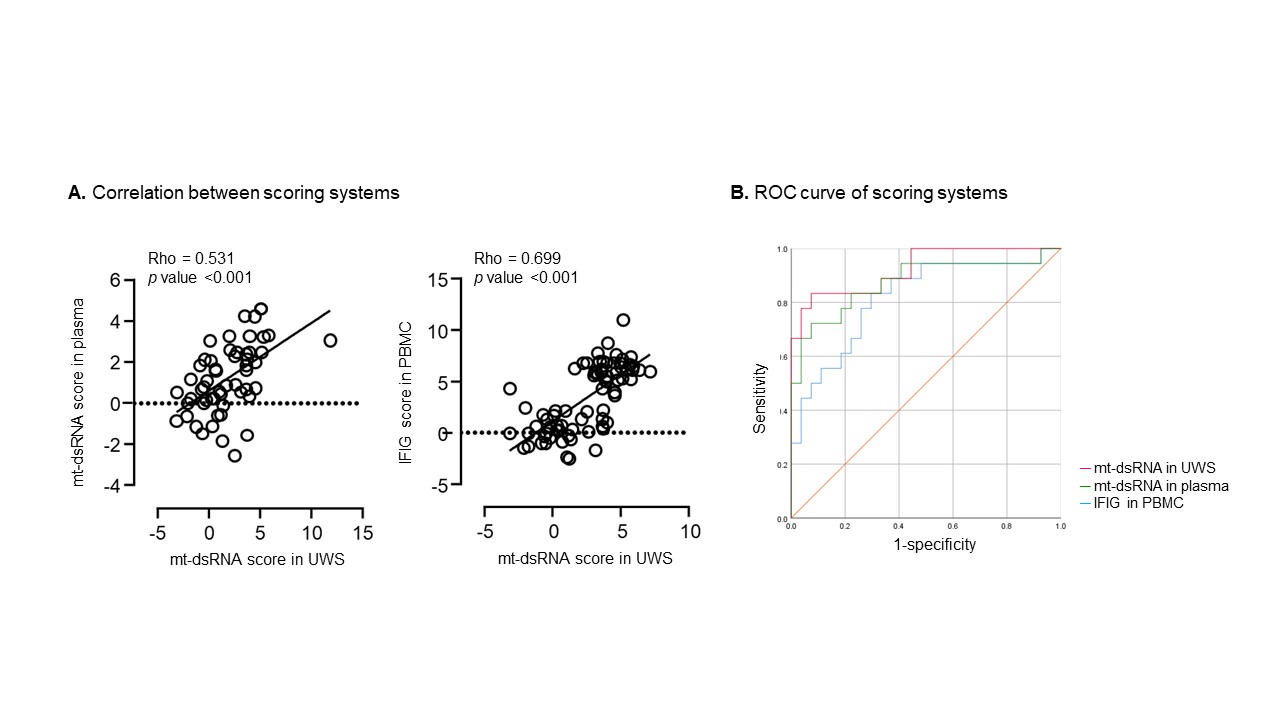Session Information
Date: Tuesday, November 14, 2023
Title: (2177–2194) Sjögren’s Syndrome – Basic & Clinical Science Poster II
Session Type: Poster Session C
Session Time: 9:00AM-11:00AM
Background/Purpose: Since mitochondrial double-stranded RNAs (mt-dsRNAs), an endogenous activator of interferon signaling, are elevated in primary Sjӧgren’s syndrome (pSS), we evaluated their association with the expression levels of interferon-inducible genes (IFIGs) and their diagnostic performance.
Methods: One hundred four pSS patients satisfying the 2016 ACR/EULAR criteria, 14 non-SS sicca patients, and 25 healthy controls were included. Seven mt-dsRNAs levels (CYTB, ND1, CO1, ND4, CO2, ND5, and ND6) in unstimulated whole saliva (UWS) and plasma samples and 8 IFIGs (IFIT1, IFIT3, IFI44, IFI44L, LY6E, OAS1, MX1, and ISG15) levels in peripheral blood mononuclear cells (PBMCs) were measured using RT-PCR. Z-score-based standardized mt-dsRNAs and IFIGs scoring systems were constructed using multivariate logistic regressions. The area under the ROC curve (AUC), sensitivity and specificity, andYouden’s index were calculated.
Results: mt-dsRNAs ND1 and ND6 in UWS and ND1 and ND4 in plasma and IFIT1, IFIT3, IFI44L, and OAS1 in PMBCs remained to be significantly associated with pSS. The mt-dsRNA score was defined as (2.16´ND1)−(1.87´ND6) in UWS and (−1.09´ND1)+(0.74´ND6) in plasma. The IFIG score in PBMC was calculated using (0.80´IFIT1)+(0.83´IFIT3)+(0.76´IFI44L) −(1.25´OAS1). Despite that they were derived from different samples, all three scores were significantly correlated mutually. The AUC of UWS (0.924) and plasma (0.874) mt-dsRNA scores were larger than that of PMBC IFIG score (0.817). With the optimal cut-off of 1.71, the sensitivity and specificity of UWS mt-dsRNA score were 97.4% and 89.7%, respectively.
Conclusion: Increased transcript levels of some mt-dsRNA in UWS and plasma were significantly associated with pSS. A novel mt-dsRNA scoring system could be a potential diagnostic marker for pSS diagnosis.
UWS = unstimulated whole saliva; OR = odds ratio; CI = confidence interval; PBMC = peripheral blood mononuclear cell
IFIG = interferon inducible genes; mt-dsRNA = mitochondrial double strand RNA; PBMC = peripheral blood mononuclear cell; SS = Sjӧgren’s syndrome; UWS = unstimulated whole saliva
AUC = area under the curve; CI = confidence interval; IFIG = interferon inducible genes; mt-dsRNA = mitochondrial double strand RNA; PBMC = peripheral blood mononuclear cell; SS = Sjӧgren’s syndrome; UWS = unstimulated whole saliva
To cite this abstract in AMA style:
CHOI S, Lee J, Choi Y, Ha Y, Kang E, Lee Y. Salivary and Plasma Mitochondrial Double-strand RNAs as a Diagnostic Biomarker for Sjӧgren Syndrome [abstract]. Arthritis Rheumatol. 2023; 75 (suppl 9). https://acrabstracts.org/abstract/salivary-and-plasma-mitochondrial-double-strand-rnas-as-a-diagnostic-biomarker-for-sj%d3%a7gren-syndrome/. Accessed .« Back to ACR Convergence 2023
ACR Meeting Abstracts - https://acrabstracts.org/abstract/salivary-and-plasma-mitochondrial-double-strand-rnas-as-a-diagnostic-biomarker-for-sj%d3%a7gren-syndrome/



